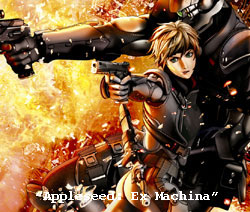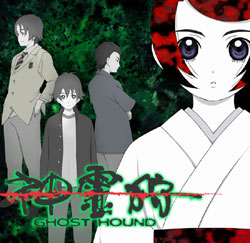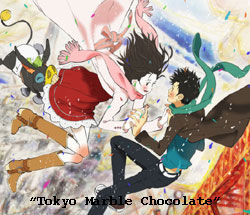Evolving Anime Films Follow New Inspirations
Question. Why are the cans of beer at the comvenience store at Terminal 2 at Narita Airport hardly chilled? Further, why does the Captain continue to make purchases given this unappealing temperature? Certainly a softball of a question for sure. But this week the newsman tackles a much more challenging puzzle: Why are anime films increasingly experimenting with their content? Over the course of finding the answer, let's just assume that the Captain surveyed the refrigerators of quite a few other convenience stores as well.
 Akihabara, the Tokyo district that's paradise for purchasing electronics and toon-related DVDs and costume wear, has recently been undergoing a makeover. The smaller specialty shops that have made the area so appealing to legions of nerds and geeks (who are known as otaku) are slowly being squeezed out by mainstream emporiums.
Akihabara, the Tokyo district that's paradise for purchasing electronics and toon-related DVDs and costume wear, has recently been undergoing a makeover. The smaller specialty shops that have made the area so appealing to legions of nerds and geeks (who are known as otaku) are slowly being squeezed out by mainstream emporiums.
But the Akihabara Enta Matsuri (Entertainment Festival), running concurrently with the Tokyo Intl. Film Festival from Oct. 20 to 28, might give these otaku a reprieve.
In addition to displays and seminars on the latest in fantasy-related publishing, videogames and software, the Enta Matsuri will focus on an anime biz seeking more mainstream appeal.
Both Enta Matsuri and TIFF fall under the auspices of the first Japan Intl. Contents Festival -- or CoFesta -- an umbrella org for 18 fests and confabs, lasting 40 days and covering movies, games, animation, manga, music and broadcasting.
Anime on television has long been dominated by the tried-and-true formula of adapting a storyline from a popular manga, a practice that is reflected in many of the episodes screening at Enta Matsuri's Animecs showcase, such as satcaster Wowow's "Moonlight Mile" and TV Asahi's "Zombie-Loan."
 By comparison, anime films, which have typically topped the B.O. with themes intended for children (typically battling robots and big-eyed girls), are increasingly being shaped for wider audiences through new means of expression and different sources of inspiration.
By comparison, anime films, which have typically topped the B.O. with themes intended for children (typically battling robots and big-eyed girls), are increasingly being shaped for wider audiences through new means of expression and different sources of inspiration.
"The trend in anime is to experiment with various ideas," says Sachio Masugata, a representative of Enta Matsuri, which is forecast to have attendance topping 180,000, up more than 10% on last year.
Toons like this year's sci-fi epic "Vexille," directed by Fumihiko Sori (producer of "Appleseed," the 2004 sci-fi based on a manga by Shirow Masamune), continue to gather press for their revolutionary 3-D CGI and dynamism. Meanwhile, "Appleseed" sequel "Appleseed: Ex Machina," which came from studio Micott & Basara for an Oct. 20 release in Japan, does not disappoint with its slick action sequences, amazingly detailed imagery and high-energy pacing.
Helmer Shinji Aramaki credits the improved styling to his production staff.
"They have shown to me that a person's ability to evolve is much more amazing than that of computer technology," he says.
 With all of the dazzling effects in "Appleseed: Ex Machina," it is perhaps ironic that its most remarkable elements might be the strong personalities embodied in the female characters -- a stunner considering male-centric Japanese hierarchy -- and the love triangle subplot, something "Appleseed" lacked.
With all of the dazzling effects in "Appleseed: Ex Machina," it is perhaps ironic that its most remarkable elements might be the strong personalities embodied in the female characters -- a stunner considering male-centric Japanese hierarchy -- and the love triangle subplot, something "Appleseed" lacked.
"Fans of conventional films love romantic stories," Aramaki says. "So I do not see a reason why animation films cannot adopt this theme when they have the same possibilities for expression."
Likewise, Production I.G's "The Sky Crawlers," which is set to unspool in Japan next year, will contain a romantic theme. For the pic, in which a society of children lives in eternal adolescence, helmer Mamoru Oshii ("Ghost in the Shell") decided to work with young scriptwriter Chihiro Itou so that his message could reach his intended audience.
"Nowadays, there are many stories in live-action and animation that are targeting young people," producer Tomohiko Ishii explains. "However, very few of them have earnestly depicted the reality that youngsters are actually living in."
Meanwhile, even as fans wait for more visual wonder in Madhouse's "Yona Yona Penguin" (the studio's first fully 3-D CGI pic, skedded for release in December 2008 after reported below-the-line costs of $12 million), its director Rintaro ("Metropolis") agrees that technical effects are but one small way of impacting an audience.
He suggests that a more effective means of making an impression is with the storyline.
 "It is reasonable to say that children in today's society are living shallow lives," Rintaro says. "The aim of this movie is to send a message of encouragement to these children through a 6-year-old girl."
"It is reasonable to say that children in today's society are living shallow lives," Rintaro says. "The aim of this movie is to send a message of encouragement to these children through a 6-year-old girl."
Shooting for its usual audience but with a different source is Toei Animation's "Clannad," whose characters are based on a dating simulation game -- a break from the usual manga-to-TV-to-film cycle. Directed by Osamu Demaki's ("The Rose of Versailles") and released last month, it tells the story of a boy who meets a mysterious girl in a dream.
The studio feels that young people's interests have diversified, with videogames increasing in popularity.
"This is just something we are trying," says Toei Animation's Tetsuya Yokoyama, a manager in corporate strategy. "But our target is still the otaku consumer."
There are some novelty contributions to Animecs (whose sister event at TIFF will screen two Production I.G toons, the direct-to-video "Tokyo Marble Chocolate" and episodes from Wowow's "Ghost Hound"). Enta Matsuri's Masugata cites Toei Animation's "Mononoke," a Fuji Television series in which a medicine salesman travels through feudal-era Japan, as a true stab in the dark.
"It is difficult to say whether such a subject can attract an international audience," he says. "It is very conscious about being Japanese."
Note: This story originally appeared in the October 22nd issue of Variety.

